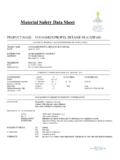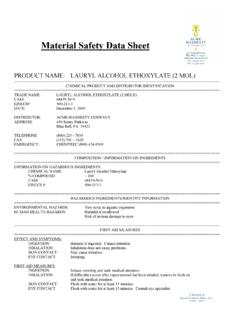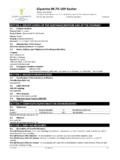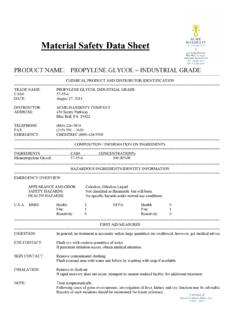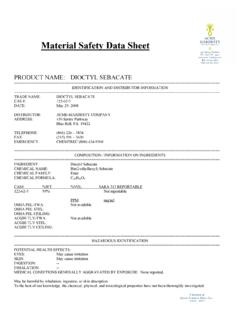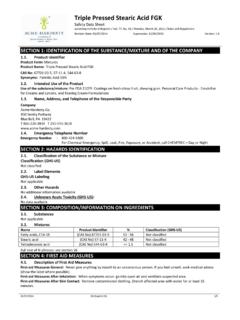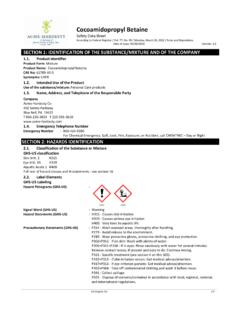Transcription of Hydrogenated Castor Oil - Acme-Hardesty
1 Hydrogenated Castor Oil Safety Data Sheet according to Federal Register / Vol. 77, No. 58 / Monday, March 26, 2012 / Rules and Regulations Revision Date: 12/17/2013 Supersedes: 10/21/2013 Version: 12/17/2013 EN (English US) 1/5 SECTION 1: IDENTIFICATION OF THE SUBSTANCE/MIXTURE AND OF THE COMPANY Product Identifier Product Form: Substance Product Name: Hydrogenated Castor Oil Synonyms: Hydrogenated Castor Oil, HCO CAS No.: 8001-78-3 Intended Use of the Product Use of the substance/mixture: Thickener in lithium grease, emulsion in personal care applications Name, Address, and Telephone of the Responsible Party Company Acme-Hardesty Co.
2 450 Sentry Parkway Blue Bell, PA 19422 T 866-226-3834 T 215-591-3610 Emergency Telephone Number Emergency Number : 800-424-9300 For Chemical Emergency, Spill, Leak, Fire, Exposure, or Accident, call CHEMTREC Day or Night SECTION 2: HAZARDS IDENTIFICATION Classification of the Substance or Mixture Classification (GHS-US) Not classified Label Elements GHS-US Labeling Not applicable Other Hazards No additional information available Unknown Acute Toxicity (GHS-US): No data available SECTION 3: COMPOSITION/INFORMATION ON INGREDIENTS Substances Name Product Identifier % Classification (GHS-US) Hydrogenated Castor oil (CAS No) 8001-78-3 100 Not classified Mixtures Not applicable Full text of H-phrases: see section 16 SECTION 4: FIRST AID MEASURES Description of First Aid Measures First-aid Measures General: Never give anything by mouth to an unconscious person.
3 If you feel unwell, seek medical advice (show the label where possible). First-aid Measures After Inhalation: When symptoms occur: go into open air and ventilate suspected area. First-aid Measures After Skin Contact: Remove contaminated clothing. Drench affected area with water for at least 15 minutes. First-aid Measures After Eye Contact: Rinse cautiously with water for several minutes. Remove contact lenses, if present and easy to do. Continue rinsing. First-aid Measures After Ingestion: Rinse mouth. Do NOT induce vomiting. Hydrogenated Castor Oil Safety Data Sheet according to Federal Register / Vol. 77, No. 58 / Monday, March 26, 2012 / Rules and Regulations 12/17/2013 EN (English US) 2/5 Most important symptoms and effects, both acute and delayed Symptoms/Injuries: Prolonged contact with large amounts of dust may cause mechanical irritation.
4 Symptoms/Injuries After Inhalation: Dust of the product, if present, may cause respiratory irritation after an excessive inhalation exposure. Symptoms/Injuries After Skin Contact: Not irritating to skin. Symptoms/Injuries After Eye Contact: Dust from this product may cause minor eye irritation. Symptoms/Injuries After Ingestion: May cause nausea, vomiting, and diarrhea. Indication of Any Immediate Medical Attention and Special Treatment Needed If medical advice is needed, have product container or label at hand. SECTION 5: FIREFIGHTING MEASURES Extinguishing Media Suitable Extinguishing Media: Use extinguishing media appropriate for surrounding fire. Carbon dioxide, dry chemical, foam, water spray, sand.
5 Unsuitable Extinguishing Media: Do not use a heavy water stream. Use of heavy stream of water may spread fire. Special Hazards Arising From the Substance or Mixture Fire Hazard: May be combustible at high temperature. Explosion Hazard: Risk of explosion by shock, friction, fire or other sources of ignition. Risk of explosion if heated under confinement. Reactivity: Stable at ambient temperature and under normal conditions of use. Advice for Firefighters Firefighting Instructions: Exercise caution when fighting any chemical fire. Protection During Firefighting: Do not enter fire area without proper protective equipment, including respiratory protection. SECTION 6: ACCIDENTAL RELEASE MEASURES Personal Precautions, Protective Equipment and Emergency Procedures General Measures: Do not allow product to spread into the environment.
6 Avoid generating dust. Can be slippery on hard, smooth walking area. For Non-emergency Personnel Protective Equipment: Use appropriate personal protection equipment (PPE). Emergency Procedures: Evacuate unnecessary personnel. For Emergency Responders Protective Equipment: Equip cleanup crew with proper protection. Emergency Procedures: Ventilate area. Environmental Precautions Prevent entry to sewers and public waters. Avoid release to the environment. Methods and Material for Containment and Cleaning Up For Containment: Avoid generation of dust during clean-up of spills. Use a soft bristle brush or conductive rubber or conductive plastic shovel.
7 Use caution, material is sensitive to initiation from sources such as heat, flame, shock, friction, or sparks. Use only non-sparking tools. Methods for Cleaning Up: Clear up spills immediately and dispose of waste safely. Reference to Other Sections See heading 8, Exposure Controls and Personal Protection. SECTION 7: HANDLING AND STORAGE Precautions for Safe Handling Additional Hazards When Processed: Use care during processing to minimize generation of dust. Hygiene Measures: Handle in accordance with good industrial hygiene and safety procedures. Wash hands and other exposed areas with mild soap and water before eating, drinking, or smoking and again when leaving work.
8 Conditions for Safe Storage, Including Any Incompatibilities Storage Conditions: Store in a dry, cool and well-ventilated place. Keep container closed when not in use. Storage Temperature: In bulk, store at about 5-10 C above melting point or at ambient temperature. Storage Area: Temperature higher than necessary degrades quality at rates dependent on time and temperature of exposure. Special Rules on Packaging: Stainless steel preferred for storage. Incompatible Products: Strong acids. Strong bases. Strong oxidizers. Hydrogenated Castor Oil Safety Data Sheet according to Federal Register / Vol. 77, No. 58 / Monday, March 26, 2012 / Rules and Regulations 12/17/2013 EN (English US) 3/5 Storage Temperature: In bulk, store at about 5-10 C above melting point or at ambient temperature.
9 Storage Area: Temperature higher than necessary degrades quality at rates dependent on time and temperature of exposure. Special Rules on Packaging: Stainless steel preferred for storage. Specific End Use(s) Thickener in lithium grease, emulsion in personal care applications SECTION 8: EXPOSURE CONTROLS/PERSONAL PROTECTION Control Parameters No Occupational Exposure Limits (OELs) have been established for this product or its chemical components. Exposure Controls Appropriate Engineering Controls : Avoid dust production. Ground/bond container and receiving equipment. Personal Protective Equipment : Gloves. Protective goggles. Dust formation: dust mask.
10 Hand Protection : Rubber gloves. Eye Protection : Chemical goggles or safety glasses. Respiratory Protection : When manufacturing or handling product in large quantities and dusts or particulates may be generated, maintain airborne concentrations below recommended limits. Workplace risk assessments should be completed before specifying and implementing respirator usage. NIOSH/MSHA approved respirators for protection should be used if respirators are found to be necessary. Other Information : When using, do not eat, drink or smoke. SECTION 9: PHYSICAL AND CHEMICAL PROPERTIES Information on Basic Physical and Chemical Properties Physical State : Solid Appearance : Flakes.
